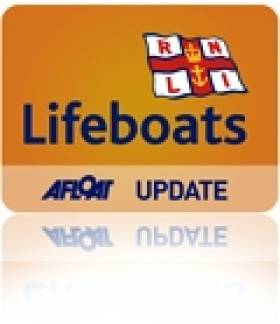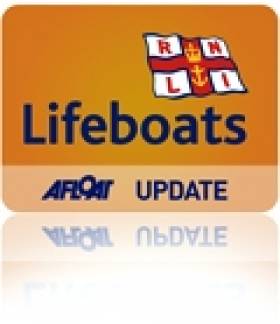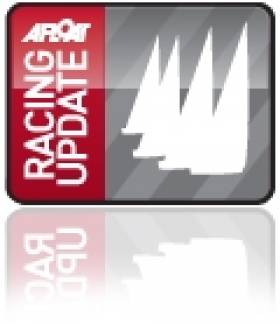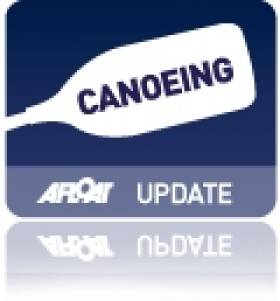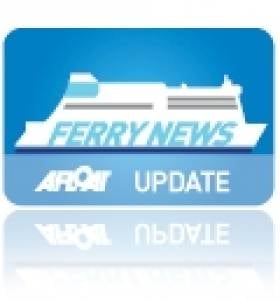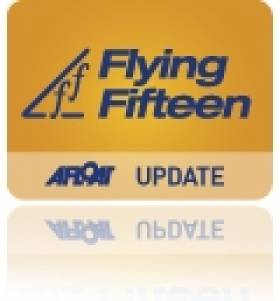Displaying items by tag: Larne
Larne RNLI Rescues Unconscious Man From Lough
#RNLI - Larne RNLI rescued an unconscious man who was found a short distance from the shore at Larne Lough last night (Thursday 20 June).
The volunteer crew launched their inshore lifeboat Hannahbella Ferguson following a request by Belfast Coastguard at 10.35pm to go to the assistance of a person who was spotted lying face down in the sea within 200 metres from the shore in Larne Lough.
Weather conditions at the time were good with a flat calm sea but light was fading.
The lifeboat - helmed by Willie Evans and with crew members Dave Somerville and Pamela Dorman onboard - arrived on scene at 10.41pm and pulled the casualty on to the lifeboat. With the man not breathing, two crew members proceeded to perform CPR and resuscitated the casualty.
The helm brought the lifeboat into a small slipway along the promenade which was accessible due to a high tide. The casualty was subsequently handed over to the waiting paramedics and ambulance.
Speaking after the call-out, Larne RNLI helm Willie Evans praised the crew who he said had worked together to resuscitate the casualty and bring him to shore.
Larne Lifeboats In Two Separate Call-Outs
#RNLI - Larne RNLI was called out for assistance on two separate occasions this past week.
On Thursday night 6 June, the volunteer lifeboat Dr John McSparran responded to a request by Belfast Coastguard to assist a lone yachtsman who had become disorientated in sea fog.
Weather conditions at the time were described as flat calm with no wind at all. However, a sea fog had come down in the evening, and the man on board - having left Girvan in Scotland en route to Glenarm Marina in an old gaffer to celebrate the Old Gaffers Association's Golden Jubilee - got into difficulty.
The casualty was located becalmed seven miles east of The Maidens Lighthouse. Lifeboat crew members Martin Agnew and Scott Leitch were put on board to assist after it was discovered that the casualty's outboard engine had failed and the gaffer was making no headway against the tide.
It was decided by Coxswain Frank Healy to tow the casualty to Glenarm, keeping the two crew members on board to assist. The vessels and crews arrived in Glenarm at 1.30am.
Two nights before, Larne RNLI assisted two men after their motor boat got into difficulty on Belfast Lough.
The volunteer crew launched their inshore lifeboat, the Hannahbella Ferguson, at 8.15pm following a request to assist the speed boat which had sustained engine failure off Muck Island.
Two men, both wearing lifejackets, were on board. Weather conditions at the time were described as good with a flat calm sea.
The casualty boat was subsequently towed safely to shore by the lifeboat to Portmuck Harbour.
Crew on this call out included helm Willie Evans, Martin Agnew and Jay Torbitt.
New Northern Ireland Yacht Race for Meningitis Trust
The great circumnavigation of Larne Lough, a 'chase race' for Meningitis is a brand new event on the Irish sailing calendar. But what is it?
To be held on Saturday 7th September and hosted by East Antrim Boat Club, it is a type of pursuit race. However in reaching into every possible creek of the Lough, together with a variety of 'on-course hurdles,' it will be a race like no other. How many races have a built in roundabout to navigate? Overall it is a fundraising day drenched with fun, frolics and challenges.
Open to mono-hulled dinghies, day boats and sports boats with a Portsmouth Yardstick number between 900 and 1600 the day will actually consist of two races; one is for the juniors which will precede the main race. Both races will feature windward starts.
The driving force for the Meningitis Chase Race is the Jobling family. Tom and Jane lost their three-year-old grandson Stanley to Meningitis. The family are well known in competitive sailing circles but this is the first time that they have taken their fundraising campaigns afloat.
Tom Jobling said; "Stanley was always a fun loving boy, always joking, smiling so another boring old sailboat race wouldn't suit him at all. The day on Larne Lough will be full of surprises, both on and off the water. Stanley's dad Barry, himself a champion sailor will be delighted if our two key objectives can be achieved.' Tom's daughter Gemma continued, "We want at least 50 assorted boats out on the water and have raised £1,000 for the Meningitis Trust. And of course have remembered Stan's smile."
Information on the Meningitis Chase Race will filter out as the big day approaches but in the meantime call the Jobling family (tel) 0044(0)2827 6960 (091 from RoI) or look into www.thechaserace.co.uk Information is also available from the East Antrim Boat Club website; www.eabc.org.uk
Larne Women To Paddle The Ban for Cancer Charity
#Canoeing - Larne women will be paddling the Bann this April all in the aid of a very good cause.
The 24-strong group from local fitness club BeFit, going by the title of the BeFit Challengers, will take to the water on 20 April for the start of a two-day canoeing expedition, along the River Bann and out to the Atlantic.
As the Larne Times reports, these ladies hope the challenge - and an epic mountain cycling event later in the year - will raise funds for Cancer Focus Northern Ireland.
BeFit owner Andrea Kernohan said: “I like to set the BeFit girls a challenge every so often, so that they have a fitness gold to work towards. I thought these Cancer Focus challenge events were perfect.
"Sadly this cause is close to mine and the girls’ hearts as so many people have been affected by cancer in one way or another.”
The Larne Times has more on the story HERE.
Sandy Bay Only 'Realistic' Spot for New Marina in Larne
#MARINAS - Sandy Bay is the only "realistic" location for the development of a new marina in the Larne area, according to a local council majority.
The Larne Times reports that a feasibility study of the borough, looking into the potential for marina facilities and watersports, identified a number of possible sites, including Curran Point and Howden's Quay, and an extension of the marina at Glenarm.
But only Sandy Bay has had any consistent interest over the years, said Alderman Roy Beggs, who described it as "the only realistic possibility for marina facilities in this borough, which we should have had 30 years ago."
Mayor Councillor Bobby McKee added that many of the sites in the report were lacking in amenities.
“Glenarm has a marina, but there is nothing else in the village to attract boat owners," he said. "The same can be said for Magheramorne and Howden’s Quay – you can’t even get a cup of coffee in these places."
The Larne Times has more on the story HERE.
Haulier and Driver Found Guilty for Failure to Declare Dangerous Goods
#FERRIES–On 19th February 2008 the Stranraer Police were alerted to an unaccompanied freight trailer which had been off loaded from the Larne to Stranraer Ferry. The officers noticed that the trailer was giving off a strange odour and that it was not placarded. They confirmed with the loading terminal at Larne that the content of the trailer was declared as peat.
When the driver arrived at 8 o clock that evening he told the police that the cargo was aluminium smeltings known locally as "skulls", a by product from smelting and that it gave off dangerous gases and could go on fire if it got wet. He gave the police a copy of the manifest which confirmed that the freight was aluminium smeltings.
The shipper was Tinnelly International Transport, a road haulier who is no longer trading, but was investigated following an incident where an explosion occurred aboard an Irish Sea Ferry on 8th July 2007. During this earlier investigation it was revealed that there is no need to placard the trailer carrying this material under EU legislation while on the road, however under the International Maritime Dangerous Goods Code it must be declared to the shipping company and the trailer must be placarded for transport by sea.
At the Magistrates Court in Larne on Friday 2nd December 2011, Mr McGivern, the driver of the tractor unit that delivered the trailer to the Port of Larne, pleaded guilty to failing to declare a cargo of dangerous goods known as Aluminium Skulls and was fined £3,000 with contribution to costs of £1,000.
Tinnelly International Transport were found guilty of failing to declare the cargo and failing to placard the vehicle, and was fined £10,000 and costs of £6,000.
On summing up the magistrate, Mr Alcorn said:
I am satisfied beyond reasonable doubt that the charges are proved. It is only by the grace of God that something didn't happen. There might have been 500 lives lost.
The driver knew what he was transporting and he risked every life on the ferry.
Mr Alcorn compared the situation to that of the Princess Victoria which still resonates in Larne to this day. None of the guilty parties have set foot in this court in the lead up to this trial, whereas all the witnesses have been brought from Northern Ireland and Scotland because of a "couldn't care less attitude".
Captain Bill Bennett, Area Operations Manager ( Northern Ireland) for the MCA stated that
"This was a serious breach of the International Maritime Dangerous Goods Code with a cargo which is known to give off gases and to explode if it comes in contact with water. P&O Ferries had already banned the product for transportation on their vessels.
McCleery and Dougan Win Western Championships at Larne
The Flying Fifteen Western Championships took place in the Larne at the weekend and were hosted by East Antrim Boat and Yacht Club.
22 crews descended on the town in what was the last event of the season. Andy McCleery & Colin Dougan (KYC) pipped Gorman/Doorly (NYC) to win their second event in succession, had the last race not been abandoned it could have been a different story . . but that's sailing!
Third overall were locals Norman Hamilton and William Rutherford.
The large contingent of classics was won by Rory McKenna & David McFarland (CAYC). Gorman's second overall was enough to put him at the top of the ranking list at the end of this season.
Irish Sea Cross Channel Fast-Ferry Services On Declining Trend
The third service between Belfast-Stranraer is in the hands of rivals Stena Line which maintain the HSS Stena Voyager (1996/19,638 grt) on sailings but only to around mid-November. She will be replaced by conventional sister-ships which will be introduced on the North Channel's newest port when services switch from Stranraer to a new terminal close to Cairnryan.
Finally the fourth fast-ferry is Irish Ferries marketed 'Dublin Swift' service which runs on the Dublin-Holyhead route served by Jonathan Swift (1999/5,989 grt). The craft built by Austal in Fremantle, operates alongside the conventional cruise-ferry Ulysses.
Stena Line's decision to terminate HSS Stena Explorer sailings between Dun Laoghaire-Holyhead this day last week follows fast-ferry Stena Lynx III's end-of-season Rosslare-Fishguard sailings earlier this month.
From next year, Dun Laoghaire-Holyhead sailings are to be seasonal-only and according to Stena Line they hope to resume fast-ferry sailings in April or May though no exact date has been set. Unlike the central corridor route which was entirely dependent on HSS operations, the Rosslare-Fishguard route remains operating year-round with the conventional ferry Stena Europe.
As a result of the discontinued fast-ferries, the HSS Stena Explorer is now spending a lay-up period in the Welsh port for the winter. The smaller Stena Lynx III is also 'wintering' but in on the opposite side of the Irish Sea in Dun Laoghaire, where the vessel has done so in previous years.
The lay-up of both fast-ferries in Dun Laoghaire and Holyhead is ironic considering that neither ports' are connected by the very craft that used to share sailing rosters in recent years. In addition the wintering of these catamaran craft is the first time that this has occurred since the pioneering Stena Sea Lynx fast-ferry launched such sailings in 1993.
This first 'Lynx' provided seasonal sailings on the route with conventional car-ferry Stena Hibernia, the former St. Columba, custom-built in 1977 for Sealink /British Rail. She was given a second name under Stena ownership, the Stena Adventurer and remained on the 57 nautical-mile route until replaced in 1996 by the year-round operated HSS Stena Explorer.
Apart from cross-channel fast-ferry services, the Isle of Man is served by the Isle of Man Steam Packet Co. Ltd's routes linking the islands capital Douglas with Belfast, Dublin, Heysham and Liverpool (Birkenhead) in the winter. These routes include seasonal services which are operated by a combination of conventional tonnage using Ben-My-Chree and fast-ferry Manannan (1998/5,089grt), a former US Navy vessel, to read more click HERE. For sailing schedules, vessel type deployed on route and for fares click HERE.
- Dublin Port
- Irish Ferries
- Dun Laoghaire
- Stena Europe
- Holyhead
- P&O Ferries
- Belfast Harbour
- Stena Line
- Larne
- Ports and Shipping News
- Ulysses
- P&O (Irish Sea)
- Cairnryan
- Ferry news
- Stena Explorer
- Stena Express
- FastFerries
- Cruiseferry
- Manannan
- Isle of Man Steam Packet Co.
- Stena Voyager
- Belast Port
- Isle of Man ferry services
- P&O Express
- Irish Sea fastferries
- Stena 'Lynx'
- BenMyChree
- Dublin Swift
- Stena Sea Lynx
Search Underway for Missing Ferry Passenger
The vessel had departed from Larne at 07.24 this morning and arrived at Cairnryan two hours later at a speed of approximately 18 knots. The master of the vessel has confirmed that one person is missing from the ships manifest.
The sea conditions are currently calm with a slight swell and good visibility with south westerly winds of 5 knots between the two locations.
A rescue helicopter, R 177, has been scrambled from the Royal Naval Air Station at Prestwick.
Clyde Coastguard are now organising a search throughout the area taking into account tidal drift and winds. Coastguard Rescue Teams have now been turned out ready to search the shores of Loch Ryan.
The Portpatrick, Stranraer and Larne RNLI lifeboats have all been requested to launch. A search has also begun from Cairnryan to Finnarts Bay. The Police Service of Northern Ireland has also been informed.
A mayday signal has now also been broadcast into the area by the Coastguard to alert passing shipping to the unfolding incident.
Ferry-Fallout as DFDS Exit Irish Sea
The routes represented a fifth of the freight market and will result in the withdrawal of the twin 21,856grt passenger ferry (ro-pax) sisters, Dublin Viking and Liverpool Viking on the 7-hour Mersey route and the 13,000grt freighter Anglia Seaways on the route to Lancashire.
In recent years, new tonnage notably in the form of four freight-only newbuilds commissioned for Seatruck Ferries on their Warrenpoint-Heysham and Dublin-Liverpool routes has added to intense competition in a crowded north Irish Sea ferry-freight sector.
The process to purchase Norfolkline's Irish Sea operations by DFDS Seaways was finally completed in mid-summer of last year. The acquisition saw the Scandinavian newcomer take control of four routes between Birkenhead-Belfast / Dublin and the freight-only Heysham-Belfast / Dublin services and a fleet of seven vessels, four (ro-pax) ferries and three freight-only vessels.
DFDS Seaways latest decision is all the more dramatic as the company in early December then sold both Belfast routes to Birkenhead and Heysham to Stena Line. In addition the £40m acquisition included the sale of the chartered 27,510 ro-pax sisters Lagan Seaways and Mersey Seaways and the 13,000grt freighter half-sisters, Scotia Seaways and Hibernia Seaways. The deal is significant in that Stena will make an inaugural foothold on the Merseyside market.
With the sea-changes swirling in the Irish Sea market, the dominant player is with out doubt Stena Line. The ferry operator closed late last year the Larne-Fleetwood route and three vessels (for more information about those vessels click here) yet the inclusion of the former DFDS Belfast-Heysham route is closely similar with neighbouring ports and newer larger vessels.
The acquisition by Stena of the loss making routes from DFDS last month also coincided with a review to be conducted by the Danish companies remaining Dublin routes to Birkenhead and Heysham. The findings of that review were concluded with this months' decision by DFDS to close down the routes, marking the Scandinavians operators brief foray on the Irish Sea ferry scene.



























